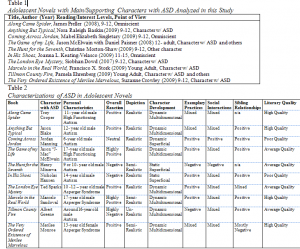Katherine Way and Professor Tina Dyches, Counseling Psychology & Special Education
We examined ten juvenile books using a qualitative, descriptive design, to evaluate the characterization of Autism Spectrum Disorders (ASD) in adolescent novels (Dyches & Prater, 2005; Dyches et al., 2001). To be included in the study, the books were required to meet four criteria. They must have (a) included a main or supporting human character with an ASD; (b) been recognized as a novel written for teenagers or young adults, in story format, including biographies written in story format; (c) been published initially in English between 2007 and 2009; and (d) been published by a commercial publisher rather than through vanity press.
The first step was to identify novels that include characters with ASD. The authors consulted with children’s literature librarians and used search terms such as autism, Asperger Syndrome, and Pervasive Developmental Disorder to locate books from various print and electronic book lists. We found over twenty children’s novels that had been published between 2007 and 2009 that included a character with an ASD, and we selected ten of these books to evaluate.
To collect data on the realistic characterizations of individuals with ASD in these novels, I used two checklists and one evaluation form. The first checklist, “Behavioral Characteristics of Autism”, was created using criteria from various autism rating scales. The second checklist, “Behavioral Characteristics of Asperger Syndrome in Picture Books”, incorporated items from scales to measure Asperger Syndrome. These checklists allowed me to record each instance of a characteristic of ASD portrayed, and the page number where it occurred.
Characterizations of the individual with ASD in each book were also submitted to content analysis according to qualitative methods described by Denzin and Lincoln (2008). As the primary reviewer, I read each book and provided a written evaluation based upon guidelines adapted from Dyches et al. (2001). These guidelines included evaluations of the portrayal of the individuals with ASD, social interactions, exemplary practices, and sibling relationships (if applicable), along with literary elements. To ensure inter-rater reliability, three other reviewers evaluated three of the books for quality characterization, and compared data with mine to compile a quantitative and descriptive summary of each item on the evaluation instrument.
Each of the books I reviewed had a character with ASD in a main or supporting role, and six were told from the point of view of the character with ASD. A list of the books analyzed in the study is displayed in Table 1. Of the ten books I reviewed, six characters with ASD were depicted realistically, three were semi-realistic and one was unrealistic. Of those characters with ASD who were portrayed realistically or semi-realistically, four of those books were rated very high literary quality, three were rated average literary quality and two were rated poor literary quality. A complete comparison of the characterization of ASD in the adolescent novels I studied is displayed in Table 2. Overall I would recommend seven of the books for their realistic or semi-realistic portrayal of individuals with ASD, and for their average to high literary quality. These recommended books are: Along Came Spider, Anything But Typical, The Game of My Life, The Hunt for the Seventh, The London Eye Mystery, Marcelo in the Real World, and the Very Ordered Existence of Merilee Marvelous.
Because the number of students diagnosed with ASD has increased dramatically in recent years, and the number of students with ASD being educated in general education settings is increasing, educating peers without disabilities about ASD is critical. The use of children’s literature is one way to help develop positive attitudes about those with ASD. Literature is a central component in educational settings and has the potential to teach children information about ASD and how they can relate to those with ASD. In order for children’s literature to be a beneficial experience, the depiction of ASD should be realistic, and the literary quality of the books should be satisfactory. Through this study, I have identified seven quality novels that accurately portray individuals with ASD. These novels can be used to help teach awareness, knowledge, understanding, and acceptance of those who are different (e.g., Matthew & Clow, 2007; Prater & Dyches, 2008).

References
- Denzin, N. K., & Lincoln Y. S. (2008). Collecting and interpreting qualitative materials (3rd ed.). Thousand Oaks: Sage Publications, Inc.
- Dyches, T. T., & Prater, M. A. (2005). Characters of developmental disability in children’s fiction. Education and Training in Developmental Disabilities, 40, 202-216.
- Dyches, T. T., Prater, M. A., & Cramer, S. F. (2001). Characterization of mental retardation in children’s books. Education and Training in Mental Retardation and Developmental Disabilities, 36, 230-243.
- Matthew, N., & Clow, S. (2007). Putting disabled children in the picture: Promoting inclusive children’s books and media. International Journal of Early Childhood, 39(2), 65-78.
